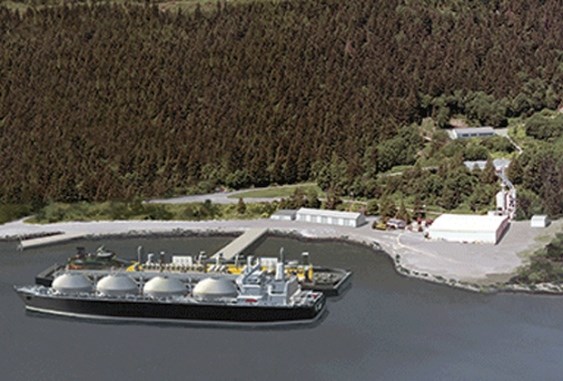With federal, provincial and First Nations environmental approvals in place, the Woodfibre LNG project has hired a Houston, Texas-based company to provide a detailed analysis of what it would cost to build an LNG plant under the terms of those permits.
Just days after the federal government announced environmental approval of the project, the company released a statement that it had hired KBR Inc. to do preliminary engineering and design work. Results of that analysis – expected in June or July – along with sales contracts with overseas customers, will be key to making a final investment decision later this year on whether to build the plant, said Byng Giraud, vice-president of corporate affairs at Woodfibre LNG Ltd.
If that happens, construction on the plant – expected to take two years - could start in early 2017, he said.
But there are still a number of hurdles for the project to clear before that happens.
Among those, “we still have a number of permits to get,” said Giraud. “The oil and gas permits are quite large. They can take months to achieve.”
Permits issued by the B.C. Oil and Gas Commission address some of the same issues as the Environmental Assessment Office approvals, but in much more detail.
A new FortisBC pipeline that would feed natural gas into the plant is also subject to further regulatory approval, including reaching agreements with the Squamish Nation.
The band, which issued its own conditional environmental approval of the project last year, also has an economic stake in the project, including a revenue-sharing deal if the project goes ahead and an agreement to provide employment.
Besides regulatory approvals, one of the biggest wild cards for the LNG project is likely a market for its product.
Global oversupply of LNG and a shrinking of Asian markets means “the market is tough right now,” said Giraud. But he added Woodfibre is likely in a better position to weather that than some of the other proposed LNG projects.
“We are a smaller facility,” he said. “Finding space for that amount of gas (in the market) is much less difficult.”
Woodfibre, whose parent company Pacific Oil and Gas Ltd., is owned by Indonesian billionaire Sukanto Tanoto, is currently in talks to secure a sales contract with Beijing Gas, said Giraud. “It all comes down to price,” he said. “It’s a negotiation we’re heavily involved in.”
The federal government gave its stamp of approval Friday to the $1.6-billion liquefied natural gas project, which plans to process and export 2.1 million tonnes of LNG each year from the site of the former Woodfibre pulp mill site on Howe Sound, southwest of Squamish. The project would send an estimated 40 double-hulled tankers to Asia each year.
In her decision, federal Minister of Environment and Climate Change Catherine McKenna said the Environmental Assessment Office has concluded the project can go ahead without causing significant harm.
Environmentalists opposed to the polarizing project expressed their shock and disappointment at the decision Friday.
Mona Benge, who lives in Horseshoe Bay in West Vancouver, called the decision “extremely disappointing. I had such hope based on the prime minister’s comments (during the election campaign) that even though governments grant permits, only communities grant permission.”
Many local governments, including West Vancouver, have come out against the project.
Benge pointed to the re-industrialization of a recovering marine environment in Howe Sound as a concern. “The whales are back. The herring are back. All of that will be impacted,” she said. “It’s bad for the environment.”
Other opponents, including Tom Rafael of West Vancouver, pointed to a planned ocean cooling system as a top concern, saying it could harm marine life in the area.
According to environmental assessment documents, the seawater cooling system proposed by Woodfibre will be anchored to the ocean floor below 25 metres. It will draw sea water through a screened intake at a rate of 17,000 cubic metres of water per hour and treat it with chlorine. It will be returned to the ocean through a diffusion system up to 10 degrees warmer than the surrounding ocean temperature.
In a response to questions posed by the environmental assessment office, environmental consultants hired by Woodfibre said the water will be returned to the ocean at a low enough depth that it will mix with colder sea water and will only remain one degree warmer than surrounding water at a distance of 10 metres. The report also stated the depth of the intake is expected to prevent many impacts on fish, which are generally found in water closer to the surface. The consultants said the level of chlorine in the water returned to the ocean will be at levels below Canadian guidelines.
Conditions attached to the federal environmental permit include monitoring shellfish and ground fish for levels of polycyclic aromatic hydrocarbons, dioxins and furans. Conditions also include minimizing gas flaring from the project’s proposed 140-metre derrick, especially during migratory bird season.
Woodfibre must also keep tabs on marine mammals in the area and stop any activity that produces high levels of underwater noise if they are spotted nearby.
Critics have voiced skepticism that government will provide sufficient oversight and monitoring of the project to ensure those conditions are enforced.
Pam Goldsmith-Jones, Liberal MP for West Vancouver-Sunshine Coast-Sea to Sky Country, said Friday after the decision was announced that the conditions are significant.
“They reflect the community input that people provided and I will be vigilant in ensuring that, from the perspective of ecological health and marine safety, those criteria will be met.”



